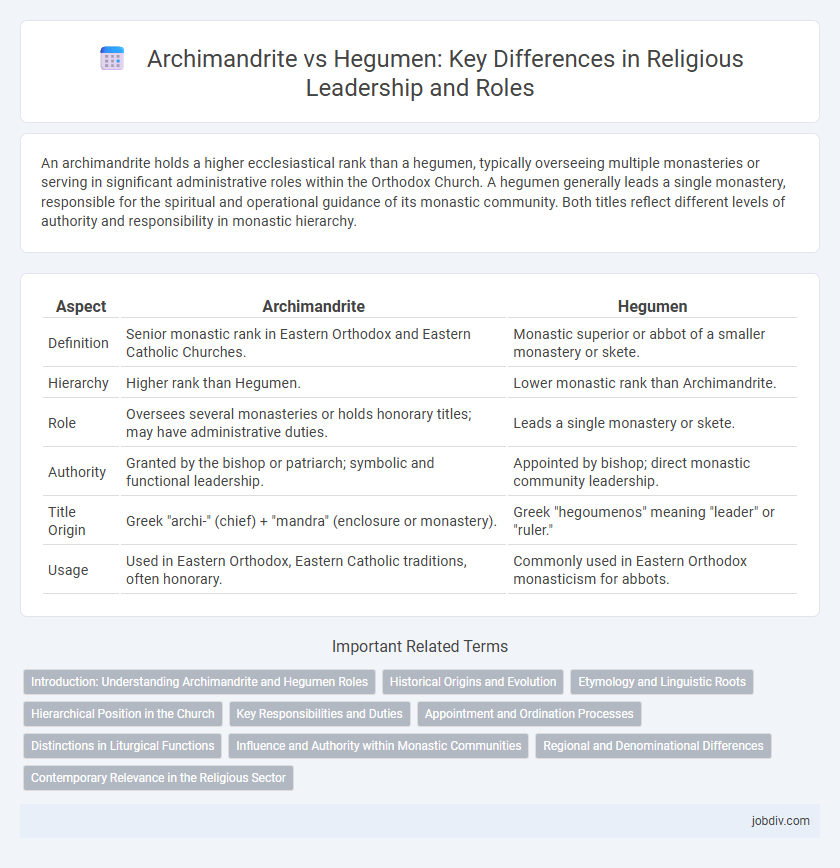An archimandrite holds a higher ecclesiastical rank than a hegumen, typically overseeing multiple monasteries or serving in significant administrative roles within the Orthodox Church. A hegumen generally leads a single monastery, responsible for the spiritual and operational guidance of its monastic community. Both titles reflect different levels of authority and responsibility in monastic hierarchy.
Table of Comparison
| Aspect | Archimandrite | Hegumen |
|---|---|---|
| Definition | Senior monastic rank in Eastern Orthodox and Eastern Catholic Churches. | Monastic superior or abbot of a smaller monastery or skete. |
| Hierarchy | Higher rank than Hegumen. | Lower monastic rank than Archimandrite. |
| Role | Oversees several monasteries or holds honorary titles; may have administrative duties. | Leads a single monastery or skete. |
| Authority | Granted by the bishop or patriarch; symbolic and functional leadership. | Appointed by bishop; direct monastic community leadership. |
| Title Origin | Greek "archi-" (chief) + "mandra" (enclosure or monastery). | Greek "hegoumenos" meaning "leader" or "ruler." |
| Usage | Used in Eastern Orthodox, Eastern Catholic traditions, often honorary. | Commonly used in Eastern Orthodox monasticism for abbots. |
Introduction: Understanding Archimandrite and Hegumen Roles
Archimandrite and hegumen are distinct ecclesiastical titles within Eastern Orthodox and Eastern Catholic monastic traditions, each signifying different levels of authority and responsibility. An archimandrite typically holds a higher rank, often overseeing multiple monasteries or serving in senior administrative roles, while a hegumen usually functions as the abbot or head of a single monastery. Understanding these roles clarifies the organizational hierarchy and spiritual leadership roles in Orthodox monastic life.
Historical Origins and Evolution
Archimandrite and hegumen originated in Eastern Orthodox monasticism, with hegumen initially serving as the abbot or head of a single monastery and archimandrite overseeing multiple monasteries or a larger monastic district. The term "hegumen" derives from the Greek word meaning "leader" or "ruler," reflecting its early use for local monastic authority, while "archimandrite" evolved to denote higher rank and administrative responsibility within the church hierarchy. Over centuries, these titles adapted to changing ecclesiastical structures, with archimandrites often granted honorary status beyond administrative roles, illustrating the evolution of monastic leadership in Orthodox Christianity.
Etymology and Linguistic Roots
Archimandrite derives from the Greek words "archi," meaning chief or principal, and "mandra," meaning sheepfold or monastery, signifying a superior monastic rank overseeing multiple communities. Hegumen, also from Greek origins, comes from "hegoumenos," meaning leader or guide, referring typically to the head of a single monastery. The linguistic roots highlight Archimandrite's broader jurisdiction compared to the more localized authority implied by Hegumen.
Hierarchical Position in the Church
An archimandrite holds a higher hierarchical position than a hegumen within the Eastern Orthodox Church. While a hegumen serves as the head of a monastery or a smaller monastic community, an archimandrite typically oversees larger monasteries or multiple monastic institutions and may have administrative authority over several hegumenoi. The rank of archimandrite is often granted as an honorary title to distinguished monks or clergy and signifies greater ecclesiastical authority and responsibility.
Key Responsibilities and Duties
An archimandrite holds a higher ecclesiastical rank than a hegumen, often overseeing multiple monasteries and serving as a senior advisor to bishops, while a hegumen is primarily responsible for the daily administration and spiritual guidance within a single monastery. Key responsibilities of an archimandrite include supervising monastic communities, representing the monastery in ecclesiastical councils, and ensuring adherence to canonical law, whereas a hegumen's duties focus on managing monastic discipline, liturgical services, and the well-being of the monks. The distinction centers on scope of authority and administrative breadth, with the archimandrite playing a more strategic role in church hierarchy.
Appointment and Ordination Processes
The appointment of an Archimandrite typically involves a higher ecclesiastical authority such as a bishop or synod, reflecting the position's senior status within monastic hierarchy. Ordination for a Hegumen, often conducted by a bishop, emphasizes serving as the head of a single monastery, with ceremonies focusing on pastoral leadership and spiritual guidance. Both roles require adherence to canonical regulations, but the Archimandrite's ordination underscores broader administrative responsibilities across multiple monastic communities.
Distinctions in Liturgical Functions
Archimandrites typically hold higher ecclesiastical authority and often preside over multiple monasteries, whereas hegumen are generally abbots of individual monastic communities. In liturgical functions, archimandrites may officiate at larger or more solemn services, reflecting their broader jurisdiction and rank within Orthodox monastic hierarchy. Hegumen conduct regular monastic liturgies and ensure daily spiritual routines within their specific monastery, emphasizing pastoral care and community leadership.
Influence and Authority within Monastic Communities
Archimandrites hold higher ecclesiastical authority than hegumens, often overseeing multiple monasteries or serving as senior advisors to bishops within Orthodox monastic hierarchies. Hegumens typically govern individual monastic communities, exercising direct spiritual and administrative leadership over their specific monastery. The influence of an archimandrite extends beyond a single monastery, often shaping regional monastic policies and representing monastic interests in broader church governance.
Regional and Denominational Differences
Archimandrite and hegumen are ecclesiastical titles within Eastern Orthodox and Eastern Catholic monastic traditions, with their usage varying significantly by region and denomination. In the Russian Orthodox Church, archimandrite denotes a senior abbot with broader administrative authority, often overseeing multiple monasteries, while hegumen typically refers to the head of a single monastery. Greek Orthodox practice may use hegumen and archimandrite more interchangeably, though archimandrite often implies higher honor or distinction bestowed by the bishop.
Contemporary Relevance in the Religious Sector
Archimandrite and hegumen serve distinct roles within Eastern Orthodox and Eastern Catholic monastic hierarchies, with the archimandrite often overseeing multiple monasteries or holding significant administrative responsibilities, reflecting contemporary needs for structured ecclesiastical governance. The title of archimandrite signifies higher ecclesiastical authority and is frequently conferred in recognition of leadership in theological education or church administration, aligning with modern demands for experienced clergy in religious institutions. Hegumens typically lead individual monastic communities, maintaining essential spiritual guidance and daily monastic operations crucial for sustaining religious traditions in today's evolving ecclesiastical environment.
archimandrite vs hegumen Infographic

 jobdiv.com
jobdiv.com